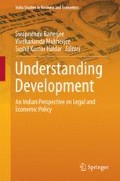Abstract
The present chapter develops a product cycle model of North-South trade and integrates the Romer (1990) model and Helpman (1993) model. In this chapter, North innovates the variety of intermediate goods, and South imitates it. Final goods are not traded, while a variety of capital-intensive intermediate goods are traded. The effect of intellectual property rights on economic growth is studied. It is shown that a unique steady-state balanced growth equilibrium may exist, or there may be multiple steady-state equilibria, and tighter intellectual property rights may lead to both a higher and a lower steady-state balanced growth rate depending on the human capital endowment of both the countries.
Access this chapter
Tax calculation will be finalised at checkout
Purchases are for personal use only
Notes
- 1.
- 2.
See Grossman and Helpman (1991b)
- 3.
- 4.
A detailed derivation is given in the Appendix.
References
Akiyama T, Furukawa Y (2009) Intellectual property rights and appropriability of innovation. Econ Lett 103:138–141
Eicher T, Penalosa CG (2008) Endogenous strength of intellectual property rights: implications for economic development and growth. Eur Econ Rev 52:237–258
Falvey R, Foster N, Greenaway D (2004) Intellectual Property Rights and Economic Growth. Research Chapter 2004/12, Research chapter series, Internationalisation of Economic Policy, The University of Nottingham
Gould DM, Gruben WC (1996) The role of intellectual property rights in economic growth. J Dev Econ 48:323–350
Grossman G, Helpman E (1991a) Quality ladders in the theory of growth. Rev Econ Stud 58:43–61
Grossman G, Helpman E (1991b) Endogenous product cycles. Econ J 101:1229–1241
Helpman E (1993) Innovation, imitation, and intellectual property rights. Econometrica 61(6):1247–1280
Lai E (1998) International intellectual property rights protection and rate of product innovation. J Dev Econ 55(1):133–153
Mondal D, Gupta MR (2008a) Intellectual property rights protection and unemployment in a North South model: a theoretical analysis. Econ Model 25:463–484
Mondal D, Gupta MR (2008b) Innovation, imitation and intellectual property rights: introducing migration in Helpman’s model. Jpn World Econ 20:369–394
Rivera Batiz LA, Romer PM (1991) Economic integration and endogenous growth. Q J Econ 106(2):531–555
Romer P (1990) Endogenous technological change. J Polit Econ 98(5):S71–S102
Schneider PH (2005) International trade, economic growth and intellectual property rights: a panel data study of developed and developing countries. J Dev Econ 78:529–547
Ventura J (1997) Growth and interdependence. Q J Econ 112(1):57–84
Acknowledgements
I am grateful to the participants of the DEGIT 2011 conference for their valuable comments.
Author information
Authors and Affiliations
Corresponding author
Editor information
Editors and Affiliations
Appendix
Appendix
Profit of intermediate good firm of North is
Using Eq. (6.15), we have
where \({x^n}\) is given by Eq. (6.2).
From Eq. (6.23), we have
From Eq. (6.15) we know that \(p_n^n = p_s^n = {p^n}\). Hence, replacing \({p^n}\) by \(p_n^n\) given by Eq. (6.11) in Eq. (6.39), we have
Using Eqs. (6.40) and (6.41), we have
Using Eqs. (6.20) and (6.42), we have
Now, using Eqs. (6.13), (6.14) and (6.18), we have
and
Equating \(w_A^n\) and \(w_Y^n\) given by the Eq. (6.25) and using the expressions of \(\frac{{x_n^s}}{{x_n^n}}\) and \(\frac{{x_s^n}}{{x_n^n}},\) we have \(H_n^Y\) given by Eq. (6.26).
Rights and permissions
Copyright information
© 2016 Springer India
About this chapter
Cite this chapter
Chakraborty, B. (2016). Trade in Intermediate Goods, Endogenous Growth and Intellectual Property Rights. In: Banerjee, S., Mukherjee, V., Haldar, S. (eds) Understanding Development. India Studies in Business and Economics. Springer, New Delhi. https://doi.org/10.1007/978-81-322-2455-6_6
Download citation
DOI: https://doi.org/10.1007/978-81-322-2455-6_6
Published:
Publisher Name: Springer, New Delhi
Print ISBN: 978-81-322-2454-9
Online ISBN: 978-81-322-2455-6
eBook Packages: Economics and FinanceEconomics and Finance (R0)

